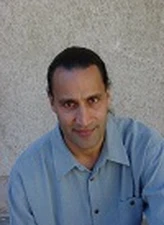Michael Manga

The 2011 Robert Wilhelm Bunsen Medal is awarded to Michael Manga for his outstanding contribution to volcanology and to the physics of transport and eruption of multiphase magma. His contribution elegantly links observations, lab experiments and theory, and has significantly advanced physical volcanology.
Michael Manga is a leading expert on magma dynamics. Most magmas are not just molten silicates but also carry crystals and bubbles of exsolved gas. It is a tough task to understand, describe and model the behaviour of such material. Michael Manga loves this task. Playing mostly with the fluid dynamical aspects of this hot and magnificent material, Manga has made a significant contribution to our present understanding of the physics of magma and to the role of bubbles and crystals in its dynamics. In his quest to understand magma, Michael Manga uses the full arsenal of scientific methods. He combines laboratory experiments and theoretical modelling with careful field observation to decipher the rheological properties of magmas and to apply this physical insight to volcanoes. Since the same principles of fluid mechanics apply to many other geological systems, he also uses his toolbox to explore the flow of streams and groundwater, the mantle dynamics of Earth and other planets, and the fracturing of the surface of icy satellites. Manga has explored a diverse range of volcanological problems. In his doctoral research he studied the interaction among moving bubbles, which he first applied to diapirs, plumes and mantle dynamics in the Earth and in Venus. With Michael’s move to Oregon and the Cascades, the volcanological role of bubbles became obvious and he joined Kathy Cashman in studying degassing of magma and the effects of gas bubbles on magma viscosity and rheology. Looking at rhyolitic flows, he deciphered the information locked in the arrangement of small crystals in these frozen magmas and, together with student John Castro, he used such information to follow the evolution of Obsidian Dome in California. Expanding his interests to the relation between permeability and porosity and to the role of magma fragmentation in enhancing permeability, he and his student Helge Gonnermann questioned the old paradigm that fragmentation marks the transition from flow of magma in the volcanic conduit to explosive eruption of ash and gas. They showed that fragmentation may also result in loss of gas and the collapse of the remaining melt to form volatile-poor magma that can continue its flow to the surface. This ground-breaking understanding that explosive volcanism is not an inevitable consequence of magma fragmentation is a wonderful example of Manga’s ability to take a fresh look at facts and his fearless quest for new interpretations. Volcanologists’ jobs became considerably more complex because of Gonnermann’s and Manga’s insight, but probably considerably more useful as well. Recently, Manga turned to exploring the dynamics of magma chambers at depth and to the evolution of clasts in pyroclastic flows.His contributions in such diverse fields as stream hydrology, volcanology and planetary interiors stem from his ability to go to the core of problems where the controlling factors all obey the same laws of physics and fluid dynamics. His profound understanding of physics enables him to combine evidence from seismology, material science, hydrology, planetary science and more to attack Nature’s hidden secrets and explain them. In volcanology, Michael Manga has joined the pioneers that transformed the field from descriptive to quantitative science.
